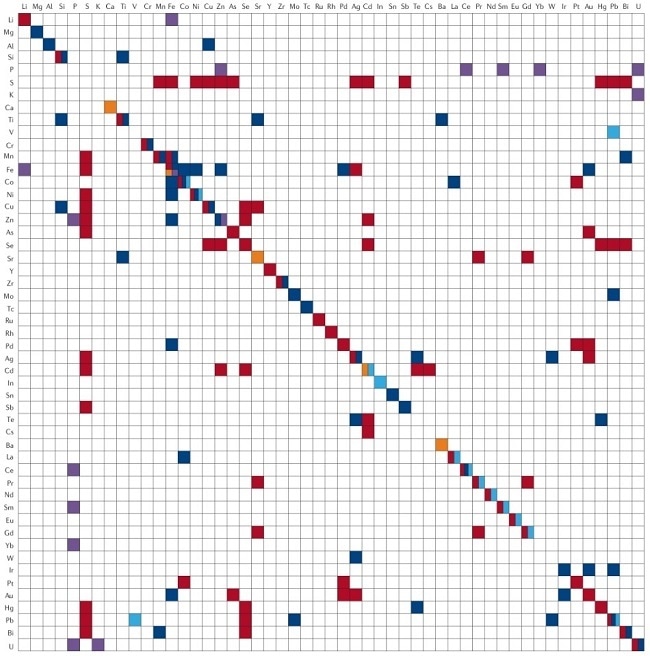Different inorganic nanomaterials can be produced using several techniques, which involve multiple experimental variables. For industries and scientists, it has been a long-time challenge to identify the best pair among various likely matches, to synthesize in an eco-friendly way.

Single- and two-element map of inorganic nanomaterials biosynthesized using microbial cells and bacteriophages. Fifty-one elements (excluding H, C, N, and O) have been used in inorganic nanomaterial synthesis using microbial cells and bacteriophages. White spaces indicate that biosynthesis of inorganic nanomaterials comprising the corresponding elements has not yet been reported. Red denotes unary or binary metal/non-metal nanomaterials that have been biosynthesized. Dark blue denotes metal/non-metal oxides that have been biosynthesized. Light blue indicates biosynthesized metal hydroxides. Light purple indicates that metal/non-metal phosphates have been biosynthesized. Orange indicates that metal carbonates have been biosynthesized. All inorganic nanomaterials biosynthesized using microbial cells and bacteriophages are listed in the paper. Image Credit: Korea Advanced Institute of Science and Technology (KAIST).
Led by Distinguished Professor Sang Yup Lee, a team of bioprocess engineering researchers from KAIST performed a summary of 146 biosynthesized single and multi-element inorganic nanomaterials, including 55 elements in the periodic table produced through wild-type and genetically engineered microorganisms.
The study emphasizes the diverse applications of biogenic nanomaterials and offers approaches to enhance the biosynthesis of nanomaterials pertaining to their crystallinity, producibility, shape, and size.
The researchers explained a 10-step flow chart to develop the biosynthesis of inorganic nanomaterials with the help of bacteriophages and microorganisms. The study was published on December 3rd, 2020, in the Nature Review Chemistry journal as a cover and hero paper.
We suggest general strategies for microbial nanomaterial biosynthesis via a step-by-step flow chart and give our perspectives on the future of nanomaterial biosynthesis and applications. This flow chart will serve as a general guide for those wishing to prepare biosynthetic inorganic nanomaterials using microbial cells.”
Dr Yoojin Choi, Study Co-Author, Korea Advanced Institute of Science and Technology
A majority of the inorganic nanomaterials are synthesized with chemical and physical techniques, and biological synthesis has been attracting much more interest. But traditional synthesis processes have disadvantages with regard to high energy consumption and non-environmentally friendly processes.
At the same time, microorganisms like microalgae, bacteria, fungi, yeasts, and even viruses can be employed as biofactories to make single and multi-element inorganic nanomaterials under mild conditions.
Following an extensive survey, the researchers concluded that the development of genetically engineered microorganisms with higher inorganic-ion-reduction ability, inorganic-ion-binding affinity, and nanomaterial biosynthetic efficiency has allowed the synthesis of several inorganic nanomaterials.
Among the approaches, the researchers included their analysis of a Pourbaix diagram for regulating the size and morphology of a product. They stated that the Pourbaix diagram analysis can be broadly used for the biosynthesis of new nanomaterials with applications in different industries.
This research provides extensive information and perspectives on the biosynthesis of diverse inorganic nanomaterials using microorganisms and bacteriophages and their applications. We expect that biosynthetic inorganic nanomaterials will find more diverse and innovative applications across diverse fields of science and technology.”
Sang Yup Lee, Distinguished Professor, Korea Advanced Institute of Science and Technology
Source:
Journal reference:
Choi, Y & Lee, S Y (2020) Biosynthesis of inorganic nanomaterials using microbial cells and bacteriophages. Nature Reviews Chemistry. doi.org/10.1038/s41570-020-00221-w.